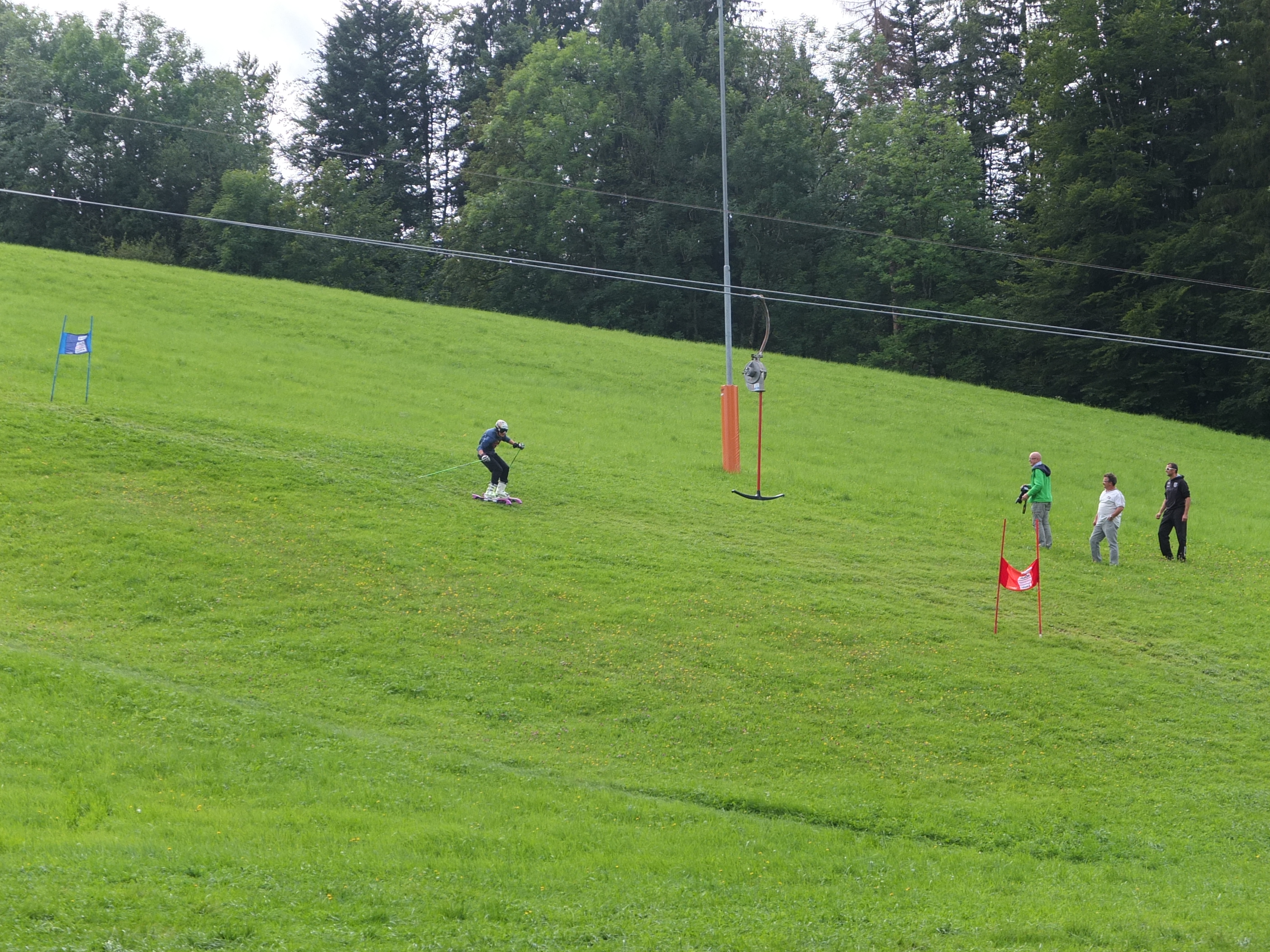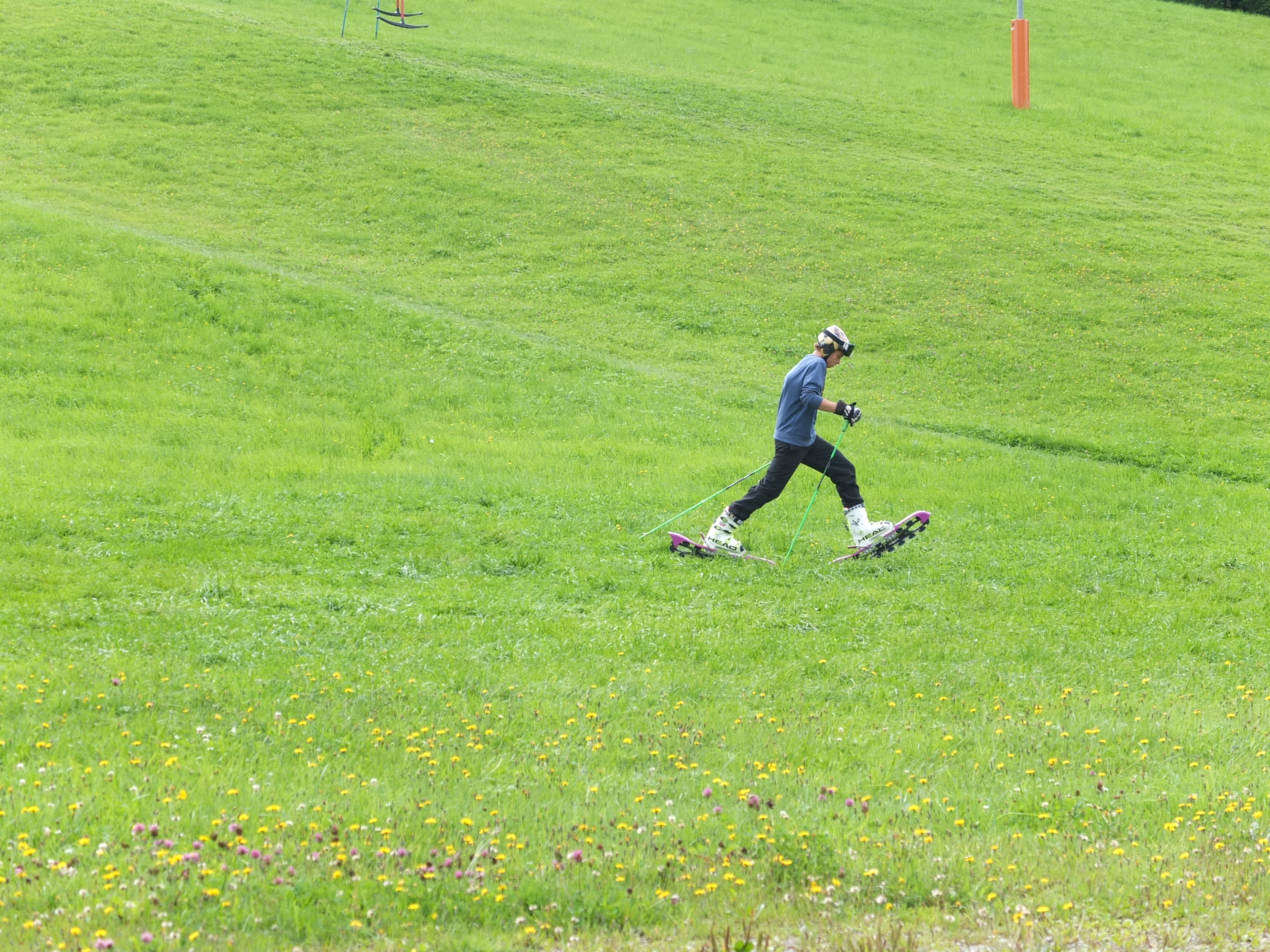It’s end of august, the grass is green, the sky is blue, it’s 20 degrees Celcius, and I am at 800m altitude, in other words: perfect conditions for downhill skiing.

Yes, I watched a Swiss regional junior team preparing for the European championships grass skiing and most probably preparing for skiing on snow in the coming winter. It’s hard to imagine that Swiss kids will be grass skiing in summer and not ski in wintertime. Most Swiss kids, especially in the mountainous areas almost learn to ski before they learn to walk.

It is amazing to observe how the movement pattern of this kind of skiing resembles skiing on snow even if the skis are rather different. So they assume this grass might, as a training stimulus, contribute to the skiing on snow. This is an important issue in many sports: the issue of transfer.
Yes, some books have already been written about this subject. Anatoli Bondartschuk, the famous hammer throwing coach, has addressed this issue in his books, but in a rather academic style. It is the merit of Martin Bingisser, the Swiss hammer thrower to have translated and simplified a lot of Bondartschuk’s work. And I will simplify it even more.
The main question is: does what you do have a positive contribution to your to your performance in competition? Yes, if you are a hammer thrower, it is rather obvious that throwing a hammer in training will improve your performance. But it depends on the volume and intensity of the throws of course. It is not like the linear thinking: the more you throw the better you get.
But is how much does bench press contribute to a better hammer throw performance? The more you get in bench press, the better your hammer throw? Power lifters wished it would be true.
And what is the contribution of a better 30 metres from the blocks? It’s even less specific and related to hammer throwing, than throwing the hammer.
Or running a marathon? I bet very few people will believe that running a marathon will lead to a positive contribution to hammer throwing.
So in anything you do apart from throwing the hammer we assume a transfer of skills and conditioning to the hammer throw. Where the bench press performance might be more related to the hammer throw than a fast time in the marathon. In the first case there is positive transfer, but in the second case a negative transfer, also called a negative interference.
As a hammer thrower you will spend more time, energy and attention in throwing hammers in training than running long distances.
There are two ways of thinking about transfer:
1. transfer of motor skills to improve the specific technical/coordination side of the movement (simply: one wants to get/or stay close to the competition movements)
2. transfer of more general conditioning exercise to the specific competition movement (simply: one is looking for transfer of conditioning exercises that somehow contribute to the competition movements by transfer)
Although these two aren’t always strictly separated.
Examples of 1: rowing ergo meter training for rowers, roller skating for speed skaters, grass skiing for downhill skiing.
Examples of 2: cycling for speed skaters, strength training for most sports, e.g bench press for shot putters and squat for sprinter or jumpers, or alternative training methods, in case of rehab or injury, e.g. training in the pool, like aqua jogging for runners.
Don’t forget: the moment you enter the weight room: forget specific exercises, unless you are a weightlifter or power lifter.
I have never seen a shot putter lying on his back in the ring trying to push the shot with two hand (it’s forbidden anyway). And think about sprinting: a squat is heavy, slow, two legs simultaneously, and vertically, while sprinting is light (only bodyweight, fast, legs extending alternately and vertically). Still there is hardly a shot putter who will not do bench press and a sprinter who will not do squats. So the assumption of transfer is a very strong one.
The complexity of the issue is that the relationship between hammer throwing in training and the hammer performance in competition isn’t stable. For beginners this relationship is strong: the more they throw the hammer, the better they get, even if it is the only thing they will do. For elite hammer throwers this is not the case, they might not be better off throwing more hammers in training.
It is the combination and integration of general exercises and specific and special exercises. It depends on the level of the athlete, on his/her development over the years, the periodisation and the adaptation dynamics of this athlete to training. It’s the subtle balance between a lot of factors and here the elite coach distinguishes him/herself from the average coach . He/she sees/realizes this complexity and manages it without getting lost in it. Or getting sidetracked.
The elite coach continuously monitors the athlete and swiftly adjusts the training loads to the actual status of the athlete, keeping in mind the long-term dynamics, like e.g. the delayed effect of training, the cumulative effects of training, the concurrent effects of training, and loss of transfer (transfer will never reach 100%).
An example from my own past as a mediocre sprinter (100m: 10.5 secs and 400m 47.4 secs). I did complex training according to Werchoshansky:
1. set of heavy squats: 5 times 160 kg: bilateral, heavy, slow, vertical
2. hurdles bounding: 1 set of 10 hurdles 1.06 m: bilateral, fast, vertical
3. bounding 10-jumps: around 35 meters: alternate, light, fast, horizontal
4. start from blocks: alternate, light, fastest, horizontal
And repeated this sequence.
The relationships with start from the blocks improved with each exercise, in other words, it became more specific. The relationship of starts from the blocks with squats is rather weak (compared to the other exercises) and through transfer in steps it is assumed that we take part of the specific qualities of each exercise with us to the next exercise.
But here is a catch: it works and it doesn’t.
If you have a lot of slow twitch muscle fibres in your leg muscles, complex training might work, but if you have a lot of fast twitch muscles in your leg muscles, they might be tired by the time you get into the blocks. That is what I learned coaching world class sprinters (with lots of fast twitch fibres).
Important lesson to learn here:
1. be careful to take your own career or experiences as an athlete as a reference for coaching other athletes, they might not be like you.
2. never copy training methods if you don’t know (in this case) the fibre type and so the responses, as published in research or by other coaches.
Bondartchuk, A.P: Transfer of Training in Sports, Part 1. Ultimate Athlete Concepts, Michigan, USA, 2007. www.ultimateathleteconcepts.com
Bondartchuk, A.P: Transfer of Training in Sports, Part 1. Ultimate Athlete Concepts, Michigan, USA, 2010.
Bingisser, G.M: Training Methodology and Concepts of Dr. Anatoli Bondarchuk;
http://www.hmmrmedia.com/bingisser

Great post again Henk. Just one comment on the last part. As you say transfer is complex. At the level of a training session it is not just one exercise to the next one…it can also happen in reverse. How you end training can impact the effect of what was done at the start. This is often overlooked. Your last two suggestions are just as important with this in mind … you need to structure a session to meet the individual athlete’s needs.
But more importantly, with transfer you don’t want to just focus on each session. You have to take a step back and work with the long-term transfer.